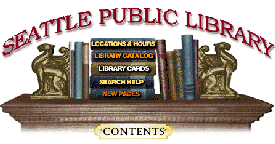Technology

Stroup describes the library as having been behind in automation before she arrived in 1988; for example, it did not yet have an online catalog. She notes that great advances in the adoption of technology since then have been “quite a remarkable paradigm shift for our staff.” Working primarily from appropriated city funds, the library has made extraordinary strides in making information in electronic form widely available throughout Seattle. In 1995, Stroup said “The Seattle Public Library is in a unique position to aid in the development of the new information infrastructure and to direct its benefits to the citizens of Seattle.”
World Wide Web Site From November 1994 to March 1996, the library’s gopher site served as the primary online guide to library information, with links to community and government information resources. Since April 1996, these information resources have been available through the library’s homepage (http://www.spl.lib.wa.us) and ongoing development has shifted to the World Wide Web environment. The main menu of this homepage leads to the library’s catalog, a guide to library services, IAC’s Magazine Index (password-controlled for use by registered borrowers), Lynx World Wide Web search facilities, a community calendar, recommended reading lists, and a directory of community organizations. Web site development is decentralized and carried out primarily by public service librarians. This ensures that the library’s web site reflects the staff’s knowledge of community information needs and understanding of the way people look for information.
Online Catalog Seattle Public Library patrons may use the online catalog of the library’s collections and place titles on reserve at terminals or workstations within the library and through dial-in, telnet, or the World Wide Web. In 1994, the library recorded 370,398 dial-in computer users.
Internet Access The library provides gateway access to the Internet free to users within or outside the library for up to 90 minutes per day. Free public Internet training classes, called “Driver’s Ed. on the Information Superhighway,” started in February 1994. These classes are offered several times per week and are filled to capacity.
Homework Centers In October 1995, the library opened its fifth homework center. It is equipped with personal computers, fax machines, copy machines, and indexes to journal articles (IAC’s Infotrac), as well as reference materials, textbooks, and tutors.
Public Information In 1994, the library unveiled a self-service government information kiosk, the Washington Information Network (WIN) kiosk, with touch screen and printer at the central library. The WIN kiosk, developed jointly by the State of Washington Department of Information Services, IBM Corporation, and North Communication, provides information from 20 state and federal agencies in English and Spanish. It lists job vacancies, vehicle registration procedures, immunization requirements, job training opportunities, small business assistance, student loan procedures, and other state information.
In October 1994, the Seattle Public Library became the first public library to offer free access to federal databases online directly from the U.S. Government Printing Office. This service enables users in the library, from branches or by dial-in or telnet, to view texts of the Congressional Record, the Federal Register, and bills of the U.S. Congress days before printed versions are made available.
An electronic geographic information system (GIS) that stores and uses information describing places on the earth’s surface has been developed by the Seattle and King County government departments for the greater Seattle area and is available for use by the public in the central library. The system brings together both spatial and descriptive data from the Seattle Comprehensive Plan and the King County Department of Planning and Community Development. It presents the information from a variety of perspectives enabling use for multiple purposes, such as land use and zoning, public facilities, natural features, hazards, and planning and infrastructure (roads, bridges, and public transit).
Computer Laboratories Through a grant from the Libraries Online! program of the Microsoft Corporation and the American Library Association, the library acquired hardware and software to equip community learning laboratories (computer labs) at four locations. Funding also provided T1-level network connections and acquisition of a CD-ROM collection for each lab. Each lab can carry live video and audio. The library has established one 17-workstation lab in the central library, a ten-workstation lab in the Rainier Beach branch, and a five-workstation site in the High Point branch. In addition, a twelve-workstation lab at West Seattle High School was established as the centerpiece of a community partnership, “West Seattle Learns,” with the high school and TCI, Inc., the local cable company.

